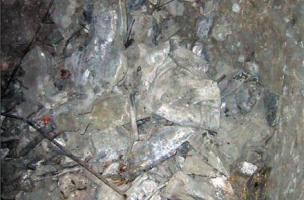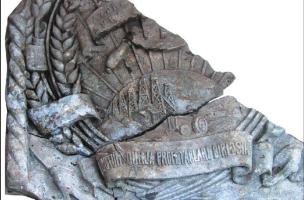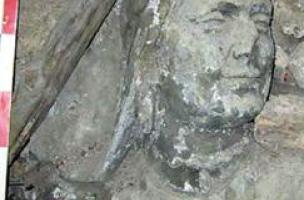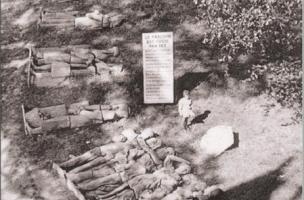Search
You are here
The archaeology of modern times: Soviet heroes in the icehouse
In advance of works in the park of Baillet-en-France castle (Val-d'Oise), an Inrap team directed by François Gentili conducted archaeological research in 2004.
Chronicle of site
Post date
29 January 2008
Last modified
19 June 2017
Originally intended to verify the presence of Medieval and Modern high status structures, things took an unexpected turn, deep into the heart of 20th century ideological upheavals.
After digging the usual test trenches, the archaeologists rapidly explored the 17th century icehouses. In one of them they discovered an impressive heap of sculpted objects, including large broken statues (2.5 to 3 m high), heads, limbs, torsos, reliefs and medallions.
After digging the usual test trenches, the archaeologists rapidly explored the 17th century icehouses. In one of them they discovered an impressive heap of sculpted objects, including large broken statues (2.5 to 3 m high), heads, limbs, torsos, reliefs and medallions.
Baku and Mount Ararat
Half buried in this jumble, they found a medallion with an inscription, a hammer and sickle, a tractor in front of a snow covered mountain and a sailing vessel. These elements unambiguously form part of the coat of arms of the Armenian Soviet Republic, which include Noah's Ark beached on Mount Ararat. Proclaimed independent in 1918, then Soviet in 1920, Armenia became a federated republic in 1936. Another medallion has different motifs and shows the oil wells of Baku which symbolize the Azerbaijan Soviet Socialist Republic.
It was immediately evident that this ensemble of objects belongs to a single, large Soviet monument erected after 1936. Its identification leaves no doubt because the only Soviet monument that existed in France at this time was the Soviet Pavilion of the 1937 Paris International Exhibition.
Film, photographs and descriptions of the Soviet Pavilion allow clear identification of the origin of the reliefs and statues of Baillet.
It was immediately evident that this ensemble of objects belongs to a single, large Soviet monument erected after 1936. Its identification leaves no doubt because the only Soviet monument that existed in France at this time was the Soviet Pavilion of the 1937 Paris International Exhibition.
Film, photographs and descriptions of the Soviet Pavilion allow clear identification of the origin of the reliefs and statues of Baillet.
The Soviet Pavilion of the Paris Exhibition of Arts and Techniques of Modern Life (1937)
The Soviet Pavilion was opposite the massive Albert Speer Nazi Pavilion, which was crowned with an eagle. One hundred and sixty metres long it increased in height from the rear to the principal façade, finishing with a 33 m high tower topped with a giant steel sculpture of a young couple. They were a Russian male labourer and a female Kolkhozian brandishing a hammer and sickle. At their feet, the emblems of the eleven Soviet republics of the time decorated two lateral blocks. These concrete reliefs and sculptures, the work of Joseph Tchaïkov, represented textile spinners, tank operators, musicians as well as a child. These are the statues discovered at Baillet-en-France.
A premonitory symbol of the confrontation with Nazism, this pavilion affirms the federalist nature of the URSS and a new conception of art, Socialist Realism, which was a rupture with the Soviet avant-gardism of the 1920's.
A premonitory symbol of the confrontation with Nazism, this pavilion affirms the federalist nature of the URSS and a new conception of art, Socialist Realism, which was a rupture with the Soviet avant-gardism of the 1920's.
Soviet Baillet-en-France
While the labourer and the Kolkhozian woman, the work of Véra Moukhina, were returned to Moscow, Tchaïkov's reliefs were offered by the USSR to the CGT union. At the height of the period of the Popular Front, the sculptures were placed by the Metallurgists Union in the park of the Baillet-en-France castle, acquired in 1937 and transformed into a holiday centre. This gift is indicative of the relations established between French unions, originating with the CGTU (Confédération générale du travail unitaire), and Soviet trades-unions.
The park was seized in 1939 after the banning of the French Communist Party and the CGT, and in November 1940 became a Pétainist youth centre. In the spring of 1941, the sculptures were destroyed. Displayed for a time on the ground after the Liberation of France, they were then relegated to and forgotten in an icehouse of the castle.
Symbols of Stalin's reign, trophies offered to the France of the Popular Front which was later crushed by Maréchal Pétain, these statues belong to one of the most famous Soviet monuments. Now, in a twist of fate, Baillet houses "Our Lady of France", which originally sat at the top of the papal pavilion of the same 1937 Exhibition.
The park was seized in 1939 after the banning of the French Communist Party and the CGT, and in November 1940 became a Pétainist youth centre. In the spring of 1941, the sculptures were destroyed. Displayed for a time on the ground after the Liberation of France, they were then relegated to and forgotten in an icehouse of the castle.
Symbols of Stalin's reign, trophies offered to the France of the Popular Front which was later crushed by Maréchal Pétain, these statues belong to one of the most famous Soviet monuments. Now, in a twist of fate, Baillet houses "Our Lady of France", which originally sat at the top of the papal pavilion of the same 1937 Exhibition.

Vue du remblai de la glacière. Enchevêtrement de statues, de reliefs et de médaillons monumentaux.
©François Gentili, Inrap

Médaillon de la république soviétique d'Azerbaïdjan.
©François Gentili, Inrap

Tête masculine coiffée d'un bonnet d'astrakan.
©François Gentili, Inrap

Tête féminine.
©François Gentili, Inrap
Curation : Regional Archaeology Service (Drac Île-de-France)
Site director : François Gentili, Inrap.
Contact(s) :
Mahaut Tyrrell
Media communication
Inrap, media partnerships and relations department
+33 (0)1 40 08 80 24
mahaut.tyrrell [at] inrap.fr


